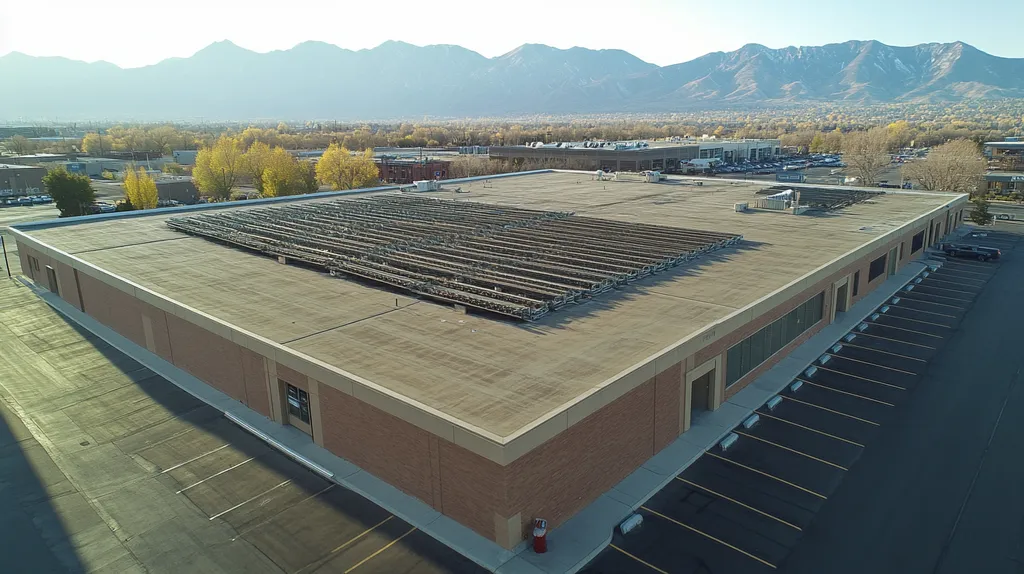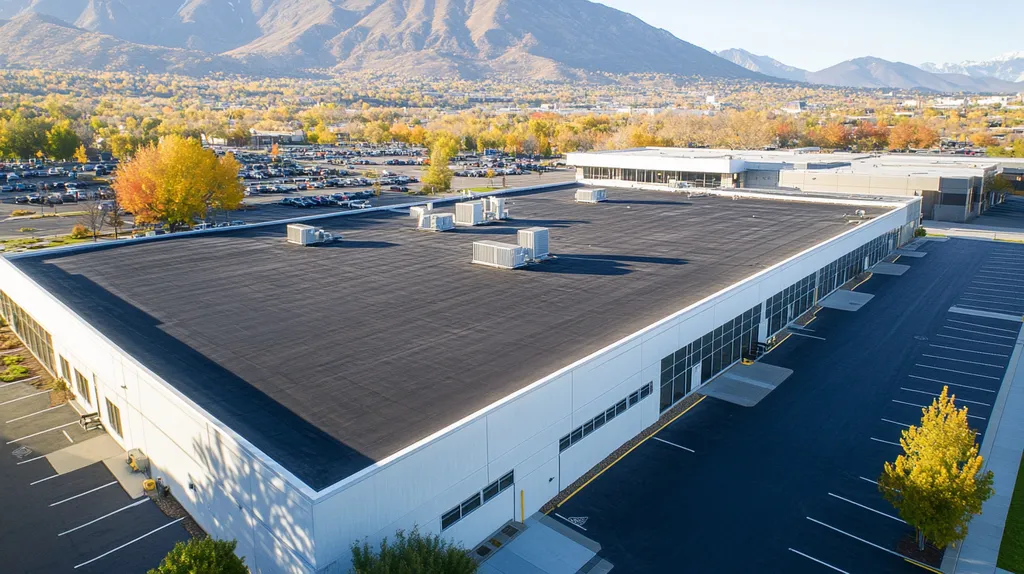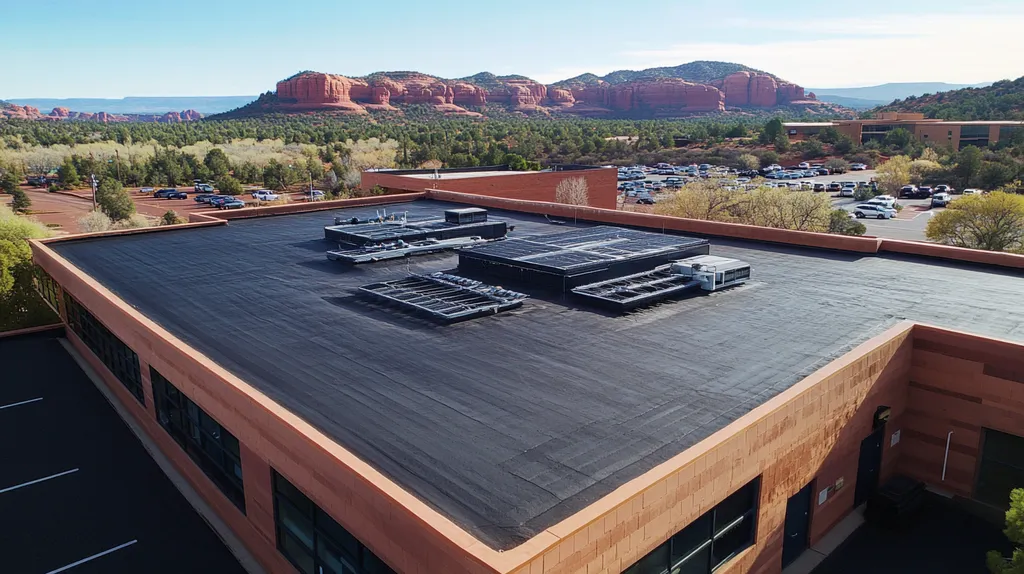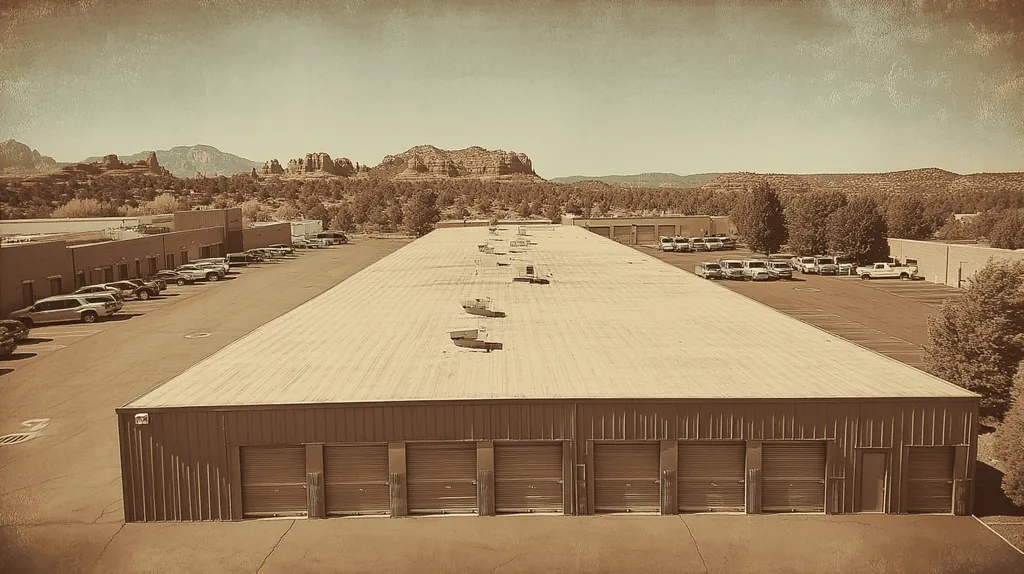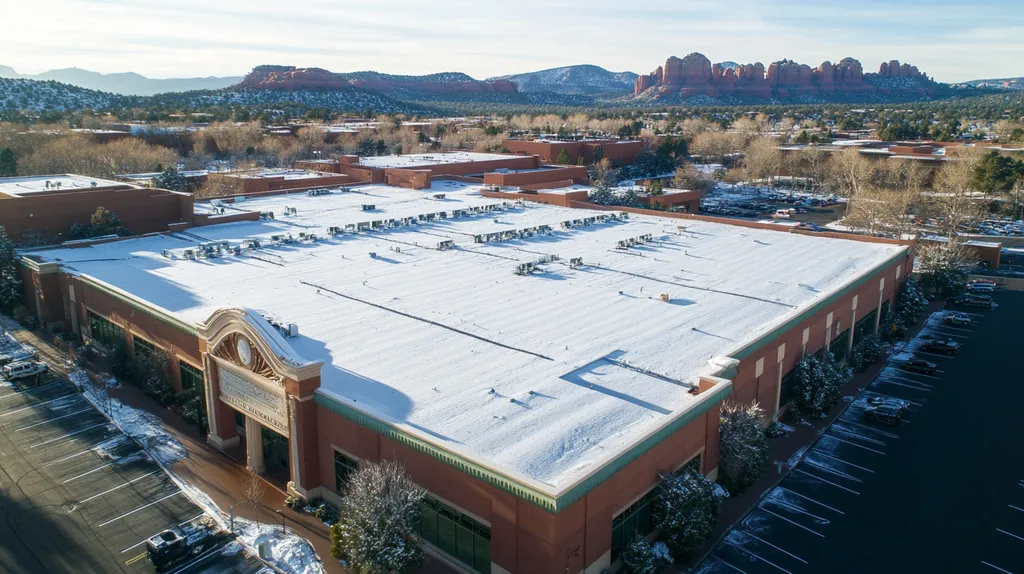Welcome to today’s Battle Royale featuring two roofing heavyweights: “Infrared Imaging” in the east corner versus “Moisture Meters” in the west!
Tonight’s showdown pits these contenders against each other across six punishing rounds designed to test every aspect of their performance for Commercial Roof Leak Detection.
At stake? Millions in potential costs, decades of building protection, and the critical performance demands of modern commercial and industrial facilities.
Our professional judging panel will evaluate each round on technical merit, real-world performance, and value delivery. After all six rounds, we’ll declare our ultimate champion.
Ladies and gentlemen, facility managers and building owners… it’s time to rumble!
ROUND 1: INITIAL COSTS & INSTALLATION
When water infiltrates a commercial roof, every minute counts. Hidden leaks can silently devastate building structures, inventory, and equipment, leading to astronomical repair costs and business disruptions. Commercial roof leak detection is a proactive service that can identify concealed issues before they escalate into major repairs, potentially reducing total roof repair costs by up to 30-40%. (source: Roof Expert)
Material Expenses
Quality infrared imaging systems represent a substantial upfront investment, typically ranging from $8,000 to $25,000 for commercial-grade equipment. This includes the thermal camera, analysis software, and required calibration tools.
Professional moisture meters present a more modest initial investment, usually between $300 and $1,500 for commercial-quality units. However, multiple units may be needed for large facilities, and replacement probes can add ongoing costs.
While moisture meters have lower initial costs, they often require more frequent replacements and updates. Infrared systems, though expensive upfront, typically maintain their effectiveness longer with proper maintenance.
For material expenses, moisture meters hold the ADVANTAGE due to their significantly lower initial investment requirements.
Installation Complexity
Infrared imaging systems demand specialized expertise for proper setup and calibration. Technicians must understand thermal patterns, environmental factors, and proper scanning techniques to achieve accurate results.
Moisture meters require minimal setup time and can be operational within minutes of unboxing. Most models feature intuitive interfaces that facility staff can master with basic training.
The simplicity of moisture meters makes them immediately useful in most situations. However, this ease of use can lead to misreadings if operators don’t understand proper testing protocols.
Installation complexity clearly favors moisture meters, giving them the ADVANTAGE in this category.
Project Timeline
Implementing infrared imaging requires careful planning and coordination. Teams must schedule scans during optimal temperature conditions and allow time for comprehensive analysis of thermal data.
Moisture meters offer immediate deployment capabilities, allowing technicians to begin testing as soon as areas of concern are identified. Results are available instantly, enabling quick decision-making.
The speed advantage of moisture meters can be crucial when addressing active leaks. While infrared imaging provides more detailed information, the extended timeline may delay critical repairs.
For project timeline considerations, moisture meters earn another clear ADVANTAGE.
ROUND 1 WINNER: MOISTURE METERS
ROUND 2: DURABILITY & LIFESPAN
When moisture infiltrates a commercial roof system, the clock starts ticking on potentially devastating structural damage. Modern leak detection methods must not only identify current issues but also preserve the roof’s integrity for future inspections. The choice between infrared imaging and moisture meters can significantly impact both immediate leak detection success and long-term roof preservation.
Equipment Resilience
Commercial-grade infrared cameras demonstrate exceptional durability under demanding roofing conditions. These systems typically maintain accuracy for 8-10 years with proper maintenance and calibration, making them a reliable long-term investment.
Most professional moisture meters require probe replacement every 12-18 months due to wear from repeated contact testing. Additionally, electrical components can degrade from exposure to moisture and environmental conditions during testing.
The non-contact nature of infrared imaging provides clear advantages for equipment longevity and consistent performance. For equipment resilience, infrared imaging claims the ADVANTAGE.
Testing Impact on Roof Materials
Infrared scanning creates zero physical impact on roofing materials, allowing unlimited testing without compromising the roof system. This non-invasive approach helps maintain warranty compliance while protecting the roof’s weather barrier integrity.
Moisture meters require direct contact and often multiple penetration points to confirm readings. Each test location creates a potential water entry point and may impact roof warranty coverage.
The preservation of roof system integrity clearly favors non-contact methods. For testing impact, infrared imaging earns the ADVANTAGE.
Long-Term Performance Tracking
Infrared imaging systems create detailed thermal maps that can be archived and compared over time. This documentation allows facility managers to track moisture patterns and predict potential failure points before leaks develop.
Moisture meters provide isolated data points that are difficult to track systematically. Without comprehensive mapping capabilities, trend analysis and predictive maintenance become challenging.
The ability to build historical performance data gives infrared imaging another clear ADVANTAGE in this category.
ROUND 2 WINNER: Infrared Imaging
ROUND 3: PERFORMANCE FACTORS
When commercial roof leaks go undetected, the consequences can be devastating. Water infiltration silently compromises structural integrity, damages expensive equipment, and creates hazardous conditions for occupants. The effectiveness of leak detection methods directly impacts a facility’s operational continuity and financial health.
Detection Accuracy
Infrared imaging systems can detect moisture penetration across vast roof surfaces with remarkable precision. These systems identify temperature variations as small as 0.1°C, allowing technicians to pinpoint water infiltration before visible damage occurs.
Dec scanning with moisture meters transmits electrical charges into the roof membrane to measure impedance levels indicating trapped moisture. This method can detect moisture up to 150mm below the surface, though it becomes unreliable on conductive membranes or during wet weather. (source: Building Transformation)
For detection accuracy, infrared imaging claims the ADVANTAGE due to its superior precision and reliability across diverse roofing systems.
Coverage Efficiency
Modern infrared systems can scan thousands of square feet per hour while maintaining consistent accuracy. This rapid assessment capability allows technicians to evaluate entire roof sections during optimal thermal conditions.
Moisture meters require systematic point-by-point testing, significantly increasing inspection time for large commercial roofs. This methodical approach often means multiple site visits to complete comprehensive evaluations.
The dramatic difference in assessment speed gives infrared imaging a clear ADVANTAGE in coverage efficiency.
Environmental Adaptability
Infrared imaging requires specific environmental conditions to produce accurate results. Scans must typically be conducted after sunset when solar loading effects have dissipated, limiting scheduling flexibility.
Moisture meters can operate effectively in most weather conditions and at any time of day. However, their effectiveness decreases in extremely wet conditions or when testing certain membrane types.
The versatility of moisture meters balances against the environmental restrictions of infrared imaging, resulting in a TIE for this category.
ROUND 3 WINNER: INFRARED IMAGING
ROUND 4: MAINTENANCE REQUIREMENTS
Commercial roof maintenance represents a critical investment protection strategy, with improper upkeep leading to premature system failure and extensive water damage. Industry data shows that properly maintained leak detection systems can extend roof life by 5-7 years while reducing emergency repair costs by up to 40%. However, each detection method carries its own maintenance burden that facility managers must carefully consider.
Calibration Requirements
Infrared imaging systems demand precise calibration to maintain accuracy. Professional technicians must perform quarterly checks and annual recertification to ensure temperature differential readings remain within 0.1°C tolerance levels.
The sophisticated sensors in these systems require careful handling and storage in controlled environments. Environmental factors like extreme temperatures or humidity can impact calibration stability, necessitating more frequent adjustments.
Moisture meters require minimal calibration, typically needing only annual verification against known moisture content samples. Their simple electrical resistance measurements remain stable under most conditions, requiring adjustment only if dropped or physically damaged.
The straightforward maintenance needs of moisture meters earn them the ADVANTAGE in this category.
Operational Maintenance
Infrared cameras need regular lens cleaning, battery maintenance, and software updates to maintain peak performance. Technicians must also periodically verify thermal sensitivity and update baseline temperature maps as roof conditions change.
Moisture meters require basic probe cleaning and occasional battery replacement. Dec scanning capabilities can detect moisture up to 150mm below the surface when properly maintained, though effectiveness varies with membrane types and weather conditions. (source: Building Transformation)
The minimal operational maintenance requirements of moisture meters give them another clear ADVANTAGE.
Staff Training Requirements
Infrared system maintenance demands extensive staff training in thermal imaging principles, environmental factors, and data interpretation. Teams must stay current with software updates and calibration procedures through ongoing certification programs.
Moisture meter maintenance requires only basic training in proper probe placement and reading interpretation. Most maintenance tasks can be performed by facility staff after brief instruction sessions.
The significant difference in training requirements gives moisture meters the ADVANTAGE in this category.
ROUND 4 WINNER: Moisture Meters
ROUND 5: SUSTAINABILITY CREDENTIALS
Commercial buildings account for over 35% of total energy consumption in developed nations, making sustainable roofing practices more critical than ever. As climate regulations tighten and energy costs soar, facility managers must evaluate how their leak detection methods impact both environmental footprint and long-term building performance.
Modern leak detection technologies can dramatically reduce waste, enhance energy efficiency, and extend roof lifespans – but only when properly implemented. The environmental impact difference between detection methods can translate into tons of avoided landfill waste and significant reductions in carbon emissions.
Environmental Impact
Infrared imaging represents a truly non-invasive inspection method that preserves roof membrane integrity. By identifying moisture issues before they require extensive repairs, this technology prevents thousands of pounds of roofing material from entering landfills each year.
The imaging process itself consumes minimal energy and generates no waste products. The detailed thermal mapping also helps optimize roof insulation performance, reducing building energy consumption throughout the year.
Moisture meters require physical penetration of roof surfaces, potentially compromising membrane integrity. Each test point creates minor damage that may require patching, generating waste material and increasing the risk of future leaks.
For environmental impact, infrared imaging claims the ADVANTAGE.
Energy Efficiency
Infrared thermography enables comprehensive evaluation of roof insulation performance and thermal bridging issues. This capability allows facility managers to address energy efficiency alongside water infiltration concerns.
The detailed thermal data helps optimize HVAC performance by identifying areas of heat loss and gain. These insights often lead to energy savings of 15-25% through targeted repairs and upgrades.
Moisture meters provide no direct energy efficiency benefits beyond basic leak detection. Their limited scope means missed opportunities for improving building thermal performance.
For energy efficiency contributions, infrared imaging earns the ADVANTAGE.
Resource Conservation
Infrared imaging helps preserve existing roof systems by enabling precise, targeted repairs. This approach maximizes the service life of roofing materials while minimizing replacement needs.
Early detection of moisture issues prevents widespread damage that could require complete roof replacement. This preservation strategy keeps functional materials in service rather than in landfills.
Moisture meters can help identify leaks but may accelerate material degradation through repeated penetration testing. Their reactive approach often leads to larger repair scopes and increased material consumption.
For resource conservation, infrared imaging secures another ADVANTAGE.
ROUND 5 WINNER: INFRARED IMAGING
ROUND 6: SPECIALIZED APPLICATIONS
Modern commercial roofing systems face unprecedented challenges, from extreme weather events to complex industrial environments. With commercial roof replacements averaging $8-12 per square foot, choosing the right leak detection method for specialized applications can mean the difference between targeted repairs and complete system failure.
Industrial Environments
Industrial facilities present unique challenges for leak detection, including chemical exposure, extreme temperatures, and specialized equipment placement. These environments demand detection methods that can operate reliably despite harsh conditions and complex roof layouts.
Infrared imaging systems excel in industrial settings by providing comprehensive scans without direct contact. Their ability to detect temperature variations through multiple roof layers helps identify problems before they affect sensitive equipment or processes.
Moisture meters often struggle in industrial environments due to electrical interference and the need for direct surface contact. Their effectiveness can be compromised by chemical residues and varying membrane compositions.
For industrial applications, infrared imaging claims the ADVANTAGE.
Roof Types and Materials
Modern commercial roofs utilize diverse materials and complex layering systems that complicate leak detection. Different membrane types, insulation materials, and deck structures require detection methods that can adapt to varying thermal and moisture characteristics.
Infrared technology effectively identifies moisture patterns across all common roofing materials, including EPDM, TPO, modified bitumen, and built-up systems. Its non-invasive approach preserves warranty coverage while providing accurate results regardless of membrane type.
Moisture meters perform inconsistently across different roofing materials, with particular challenges in conductive membranes and multi-layer systems. Their contact-based testing method may not reach deeper layers where moisture often accumulates.
When considering roof material versatility, infrared imaging earns the ADVANTAGE.
Seasonal and Weather Considerations
Seasonal changes and weather patterns significantly impact leak detection effectiveness. Temperature fluctuations, precipitation, and humidity levels can all affect the accuracy of moisture readings and thermal signatures.
Infrared systems maintain reliable performance across seasons when proper environmental conditions are met. Their ability to detect subtle temperature differences remains consistent, though optimal scanning times may vary with seasonal changes.
Moisture meters show reduced accuracy during extreme temperatures and wet conditions. Their readings can be skewed by surface moisture, making them less reliable during certain weather conditions.
For weather adaptability, infrared imaging secures the ADVANTAGE.
ROUND 6 WINNER: Infrared Imaging
AND THE WINNER IS…
After six grueling rounds of technical evaluation, we have our verdict. With a commanding 4-2 victory, INFRARED IMAGING claims the championship belt in commercial roof leak detection!
This high-tech heavyweight dominated with knockout performances in durability, performance, sustainability, and specialized applications. Its non-invasive approach, comprehensive coverage capabilities, and superior accuracy proved unbeatable in the critical categories that matter most for modern commercial facilities.
But don’t count moisture meters out completely! Their lower initial costs and simplified maintenance requirements make them valuable contenders for smaller facilities with straightforward roofing systems and budget constraints.
However, building owners and facility managers must remember: Every commercial property represents its own unique battlefield. Local climate conditions, roof system specifications, and operational requirements can all impact detection method effectiveness. This analysis provides general guidance, but cannot account for all variables that might influence performance in specific situations. Professional consultation remains essential for determining the optimal approach for individual facilities.
Ladies and gentlemen, in the high-stakes arena of commercial roof protection, the real victory comes from matching your facility’s specific challenges with the right technological champion. Choose wisely – millions in assets and decades of building performance hang in the balance!
FREQUENTLY ASKED QUESTIONS
Q. What are initial costs for leak detection on my commercial roof?
A. Infrared imaging systems range from $8,000 to $25,000, while moisture meters are cheaper, between $300 and $1,500. While moisture meters are more affordable, they may require multiple units for larger facilities, leading to higher overall costs over time. Choose based on your facility’s long-term needs and budget considerations.
Q. How durable are moisture meters compared to infrared imaging for commercial roofs?
A. Infrared imaging systems typically last 8-10 years with proper maintenance, while moisture meters require probe replacements every 12-18 months. The non-contact nature of infrared helps maintain its durability, making it a more reliable long-term investment for commercial roofs.
Q. Which method is more accurate for detecting leaks in my commercial roof?
A. Infrared imaging systems excel in detection accuracy, identifying temperature differences as small as 0.1°C. In contrast, moisture meters detect moisture up to 150 mm below the surface but can struggle under various conditions. Therefore, infrared imaging is often the superior choice for precise leak detection.
Q. What are the maintenance needs for moisture meters on my industrial roof?
A. Moisture meters require minimal maintenance, typically needing only annual calibration and battery replacements. They are straightforward for facility staff to maintain after basic training, making them an easy choice for commercial roofing scenarios. Regular checks ensure ongoing reliability in leak detection.
Q. How do leak detection methods impact the sustainability of a commercial roof?
A. Infrared imaging is non-invasive and minimizes roof membrane damage, preserving integrity and prolonging lifespan. This reduces waste and enhances energy efficiency, positively impacting your facility’s sustainability. In contrast, moisture meters may compromise roof materials, increasing repair needs and material waste over time.
Q. Can infrared imaging be used effectively in specialized industrial roof applications?
A. Yes, infrared imaging is particularly effective in industrial settings, providing comprehensive scans without direct impact. It detects temperature differences across complex roof layouts and extreme weather conditions. This capability is essential for early problem identification, helping protect sensitive equipment and processes in industrial environments.
Q. Is environmental adaptability important for detecting leaks in my commercial roof?
A. Environmental adaptability is crucial for effective leak detection. Infrared imaging requires specific conditions for accurate results, while moisture meters function in most weather. However, their readings can be skewed in extreme conditions. Understanding these differences helps facility managers select the right method for their needs.

